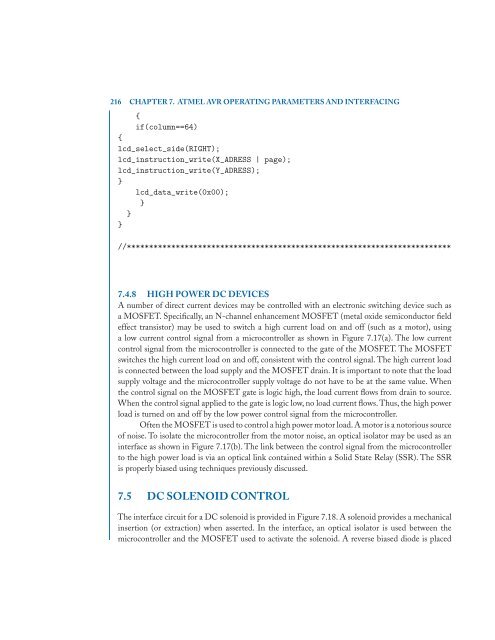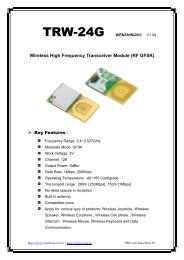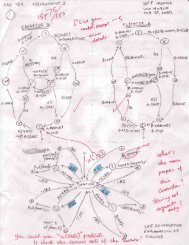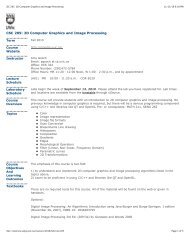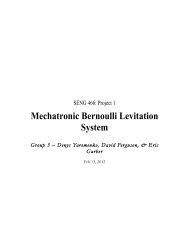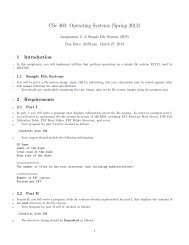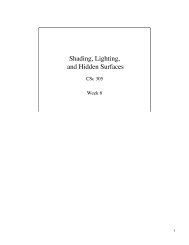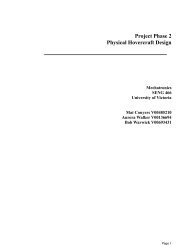Embedded Systems Design with the Atmel AVR Microcontroller Part II
Embedded Systems Design with the Atmel AVR Microcontroller Part II
Embedded Systems Design with the Atmel AVR Microcontroller Part II
Create successful ePaper yourself
Turn your PDF publications into a flip-book with our unique Google optimized e-Paper software.
216 CHAPTER 7. ATMEL <strong>AVR</strong> OPERATING PARAMETERS AND INTERFACING<br />
{<br />
if(column==64)<br />
{<br />
lcd_select_side(RIGHT);<br />
lcd_instruction_write(X_ADRESS | page);<br />
lcd_instruction_write(Y_ADRESS);<br />
}<br />
lcd_data_write(0x00);<br />
}<br />
}<br />
}<br />
//*************************************************************************<br />
7.4.8 HIGH POWER DC DEVICES<br />
A number of direct current devices may be controlled <strong>with</strong> an electronic switching device such as<br />
a MOSFET. Specifically, an N-channel enhancement MOSFET (metal oxide semiconductor field<br />
effect transistor) may be used to switch a high current load on and off (such as a motor), using<br />
a low current control signal from a microcontroller as shown in Figure 7.17(a). The low current<br />
control signal from <strong>the</strong> microcontroller is connected to <strong>the</strong> gate of <strong>the</strong> MOSFET. The MOSFET<br />
switches <strong>the</strong> high current load on and off, consistent <strong>with</strong> <strong>the</strong> control signal. The high current load<br />
is connected between <strong>the</strong> load supply and <strong>the</strong> MOSFET drain. It is important to note that <strong>the</strong> load<br />
supply voltage and <strong>the</strong> microcontroller supply voltage do not have to be at <strong>the</strong> same value. When<br />
<strong>the</strong> control signal on <strong>the</strong> MOSFET gate is logic high, <strong>the</strong> load current flows from drain to source.<br />
When <strong>the</strong> control signal applied to <strong>the</strong> gate is logic low, no load current flows. Thus, <strong>the</strong> high power<br />
load is turned on and off by <strong>the</strong> low power control signal from <strong>the</strong> microcontroller.<br />
Often <strong>the</strong> MOSFET is used to control a high power motor load. A motor is a notorious source<br />
of noise. To isolate <strong>the</strong> microcontroller from <strong>the</strong> motor noise, an optical isolator may be used as an<br />
interface as shown in Figure 7.17(b). The link between <strong>the</strong> control signal from <strong>the</strong> microcontroller<br />
to <strong>the</strong> high power load is via an optical link contained <strong>with</strong>in a Solid State Relay (SSR). The SSR<br />
is properly biased using techniques previously discussed.<br />
7.5 DC SOLENOID CONTROL<br />
The interface circuit for a DC solenoid is provided in Figure 7.18. A solenoid provides a mechanical<br />
insertion (or extraction) when asserted. In <strong>the</strong> interface, an optical isolator is used between <strong>the</strong><br />
microcontroller and <strong>the</strong> MOSFET used to activate <strong>the</strong> solenoid. A reverse biased diode is placed


